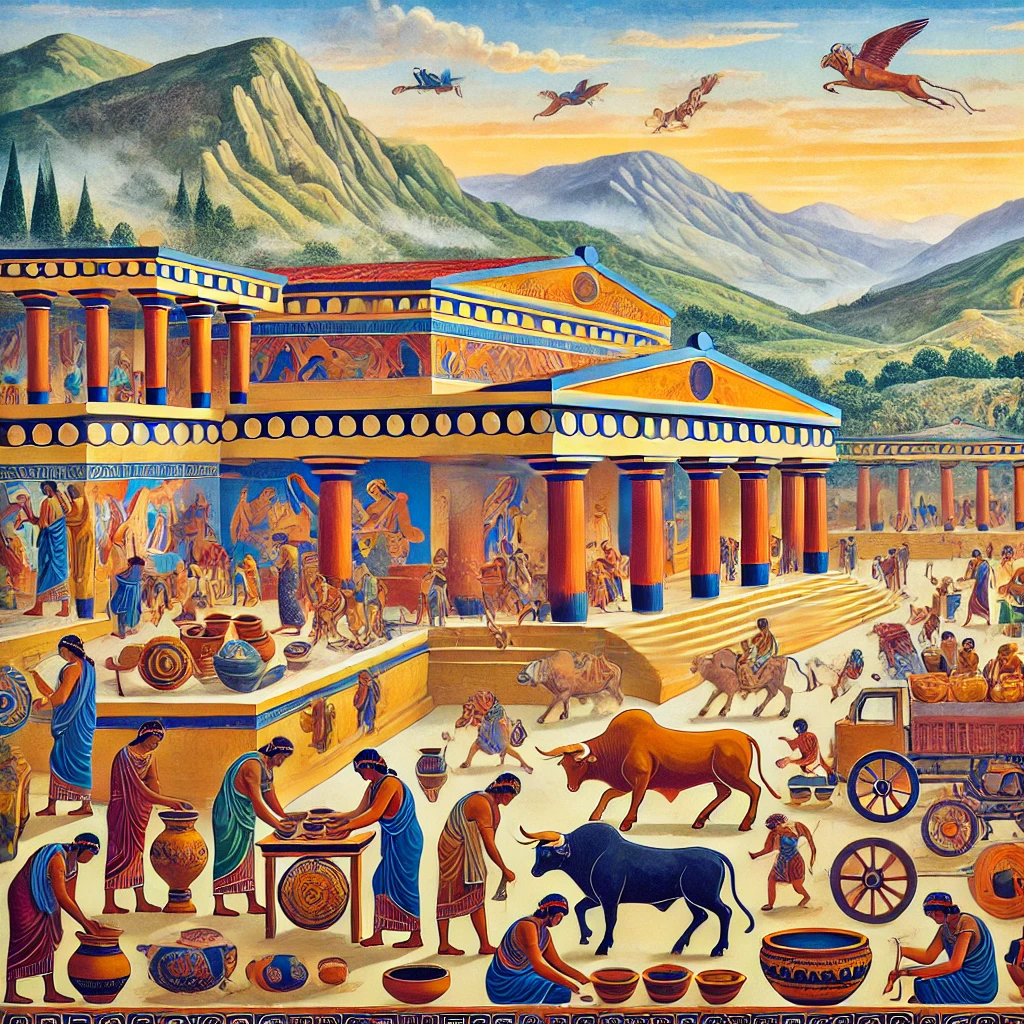The Aegean Sea, a cradle of ancient cultures, is home to the first great civilization of the Aegean Sea: the Minoan civilization. Emerging around 2600 BCE on Crete, the Minoans thrived for centuries due to their advanced maritime trade, impressive architectural feats, and sophisticated art. As Europe’s earliest complex society, they laid essential foundations for subsequent cultures in the region. In this blog post, we will explore the Minoan civilization’s rise, key characteristics and achievements, and their eventual decline and enduring legacy.
The Rise of the Minoan Civilization
The first great civilization of the Aegean Sea, the Minoans, emerged on the island of Crete around 3000 BCE. This civilization flourished due to its strategic location, which facilitated maritime trade and cultural exchange with Egypt, the Near East, and mainland Greece.
Key Factors for Minoan Rise:
- Geography: The island’s fertile land and mild climate supported agriculture, providing sustenance for a growing population.
- Seafaring Prowess: The Minoans developed advanced shipbuilding techniques, enabling them to control sea routes.
- Technological Innovation: They created sophisticated tools and weapons, enhancing agricultural productivity and trade.
Societal Developments:
- Urbanization: Establishment of significant cities such as Knossos, Phaistos, and Malia.
- Political Structure: Likely a centralized authority with a ceremonial and possibly theocratic leadership.
- Art and Architecture: Notable for stunning frescoes, intricate pottery, and grand palaces.
As the first great civilization of the Aegean Sea, the Minoans set the foundation for future Aegean cultures through their innovations in trade, governance, and artistic expression.
Key Characteristics and Achievements of the Minoans
The Minoan civilization, often recognized as the first great civilization of the Aegean Sea, exhibited remarkable characteristics and achievements that set them apart. Understanding these traits sheds light on their significant societal contributions and innovations.
Key Characteristics:
- Advanced Architecture: The Minoans are renowned for their sophisticated palace complexes, particularly the Palace of Knossos, which featured advanced engineering techniques and elaborate frescoes.
- Art and Culture: Minoan art is exceptional, notable for its vibrant frescoes, pottery, and sculptures depicting natural and religious themes.
- Religion and Rituals: The Minoans practiced a matriarchal religion, worshipping goddesses, and conducted elaborate religious ceremonies and festivals.
- Trade and Economy: Their strategic location facilitated extensive trade networks across the Mediterranean, making them prosperous merchants.
Achievements:
- Linear A Script: Minoans developed the undeciphered Linear A script, showcasing their linguistic advancements.
- Shipbuilding Excellence: They built advanced ships, enhancing their maritime prowess and trade capabilities.
- Cultural Influence: Their art and architectural styles influenced later Greek civilizations, leaving a lasting legacy.
These accomplishments underscore the Minoan civilization’s pivotal role in the history of the first great civilization Aegean Sea. Their innovative spirit and cultural contributions continue to resonate through subsequent millennia.
The Decline and Legacy of the Minoan Civilization
The decline of the first great civilization of the Aegean Sea, the Minoans, remains a topic of intrigue and speculation. Several theories suggest possible causes, including natural disasters and invasions.
Possible Causes of Decline
- Natural Disasters: The eruption of the Thera volcano around 1600 BCE likely caused significant damage and contributed to the civilization’s downfall.
- Invasions: The Mycenaeans, another ancient Greek civilization, possibly invaded and took over the Minoan territories.
Legacy of the Minoans
Despite their decline, the Minoans left behind a lasting legacy:
- Art and Architecture: Their intricate frescoes, pottery, and palace complexes, particularly the renowned Palace of Knossos, influenced subsequent cultures.
- Maritime Trade: The Minoans excelled in seafaring and trade, establishing a sturdy commercial network across the Aegean Sea.
- Writing: The Linear A script, though undeciphered, demonstrates their sophisticated administrative systems.
| Aspect | Minoans’ Contribution |
|---|---|
| Art and Architecture | Frescoes, pottery, Palace of Knossos |
| Maritime Trade | Extensive trade networks in the Aegean Sea |
| Writing | Development of the undeciphered Linear A |
By understanding the decline and enduring legacy of the first great civilization of the Aegean Sea, we better appreciate how the Minoans shaped the cultural and historical landscape of ancient Greece.
Frequently Asked Questions
What is the first great civilization of the Aegean Sea?
The first great civilization of the Aegean Sea is the Minoan civilization. Flourishing from approximately 2600 to 1100 BCE, the Minoans were known for their advanced architecture, vibrant frescoes, and extensive trade networks. They inhabited the island of Crete and were among the earliest cultures to develop in the European Bronze Age.
Why is the Minoan civilization significant?
The Minoan civilization is significant for several reasons. Firstly, it is considered the first advanced civilization in Europe. The Minoans developed a complex society with sophisticated art, architecture, and religious practices. Their palaces, such as the famous Palace of Knossos, featured advanced structural designs and elaborate decorations. Additionally, they had extensive trade networks with other civilizations, including Egypt and the Near East, which facilitated cultural and technological exchange.
What were some key contributions of the Minoan civilization to later cultures?
The Minoan civilization had a lasting influence on later cultures, especially the Mycenaeans, who succeeded them. Key contributions include advancements in architectural techniques, such as multi-story buildings and the use of columns. The Minoans also developed Linear A, an early form of writing, and their art and religious practices heavily influenced the Mycenaean civilization. Elements of Minoan culture permeated Greek mythology and can be seen in stories like the legend of the Minotaur.
How did the Minoan civilization decline?
The decline of the Minoan civilization is attributed to a combination of natural disasters and external invasions. Around 1450 BCE, a massive volcanic eruption on the nearby island of Thera (modern-day Santorini) caused widespread destruction and may have triggered tsunamis and climatic changes that impacted Crete. Additionally, archeological evidence suggests that the Mycenaeans from mainland Greece invaded and took over Minoan cities, leading to the eventual downfall of Minoan dominance in the region.


